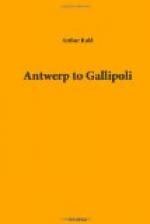In the dark shadow of the tall old houses a few people came out and stood there watching silently, and, as one felt, in a sort of despair. All night long men were marching by—and in London they were still reading that it was but a “demonstration” the Germans were engaged in— down the quay and across the pontoon bridge—the only way over the Scheldt—over to the Tete-de-Flandres and the road to Ghent. They were strung along the street next morning, boots mud-covered, mud-stained, intrenching shovels hanging to their belts, faces unshaven for weeks, just as they had come from the trenches; yet still patient and cheerful, with that unshakable Flemish good cheer. Perhaps, after all, it was not a retreat; they might be swinging round to the south and St. Nicholas to attack the German flank...
But before they had crossed, another army, a civilian army, flowed down on and over the quay. For a week people had been leaving Antwerp, now the general flight began. From villages to the east and southeast, from the city itself, people came pouring down. In wagons drawn by huge Belgian draft-horses, in carts pulled by the captivating Belgian work dogs, panting mightily and digging their paws into the slippery cobbles; on foot, leading little children and carrying babies and dolls and canaries and great bundles of clothes and household things wrapped in sheets, they surged toward that one narrow bridge and the crowded ferry-boats. I saw one old woman, gray-haired and tanned like an Indian squaw with work in the fields, yet with a fine, well-made face, pushing a groaning wheelbarrow. A strap went from the handles over her shoulders, and, stopping now and then to ask the news, she would slip off this harness, gossip for a time, then push on again. That afternoon under my window there was a tall wagon, a sort of hay wagon, in which there were twenty-two little tow-headed children, none more than eight or ten and several almost babies in arms. By the side of the wagon a man, evidently father of some of them, stood buttering the end of a huge round loaf of bread and cutting off slice after slice, which the older children broke and distributed to the little ones. Two cows were tied to the back of the wagon and the man’s wife squatted there milking them. All along the quay and in the streets leading into it were people like this—harmless, helpless, hard-working people, going they knew not where. The entrance to the bridge was soon choked. One went away and returned an hour later and found the same people waiting almost in the same spot, and, with that wonderful calm and patience of theirs, feeding their children or giving a little of their precious hay to the horses, quietly waiting their turn while the cannon which had driven them from their homes kept on thundering behind them.




